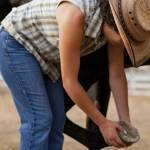Diagnosing and Treating Coffin Bone Fractures in Horses

The coffin bone, also known as the pedal bone or distal phalanx, is a small bone within the horse’s hoof. It is the anatomic equivalent of the bone that forms the fingertip on a human’s middle finger or toe. Lying close to the sole of the horse’s hoof, the coffin bone can be broken if the horse lands on a rock or comes down with unusually intense force on one hoof after a jump. Some coffin bone fractures don’t involve a single impact but are thought to result from cumulative stress, while in other horses these injuries may be related to a genetic tendency for a fracture in a particular spot in the coffin bone.
Sudden lameness is one sign of a coffin bone fracture, especially if it is noticed during or immediately after exercise in a horse that was previously sound. Heat and an increased digital pulse usually accompany the lameness. Radiographs or other imaging techniques can be used to diagnose a fracture, though a hairline crack may not show up well until a week or so after the injury occurs. Fractures can involve the tip of the bone, one or both outer edges, or a line along the center of the bone. Injuries that consist of chips or breaks at the end or sides have a somewhat better prognosis than fractures that involve the joint at the top of the coffin bone.
Treatment is designed around immobilizing the bone and decreasing pain and inflammation. For most small, clean fractures, the horse can have a bar shoe applied to keep the hoof wall from moving. This stabilizes the structures inside the hoof and allows the bone to heal. If there are multiple fractures, the prognosis is not as good and healing will take longer. Anti-inflammatory medications and cold hosing or soaking will help to control pain. Stall rest, possibly for several months, will limit movement as the fracture heals. The horse may appear sound well before the break is completely repaired, but returning the horse to work too soon greatly increases the risk for reinjury.
If the broken part of the bone is small and doesn’t involve the joint, many horses heal well and can return to their previous level of performance. More complicated fractures could require surgery, removal of chips or slivers of bone, and plates or screws to stabilize the bone. Horses might require a full year out of work to recover completely from some coffin bone fractures. Any return to work after injuries and layoffs should be very gradual, and the horse should be monitored closely for any sign of pain or lameness.








